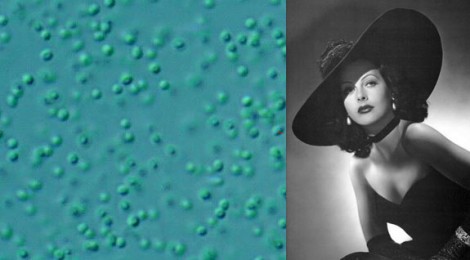
Plankton Blooms Are Sentient Life Based On A Distributed Mesh Network Megamind
There is some amazing news about life on this blue planet.
It seems that there is sentient life in the oceans.
But in an unexpected form, in plankton blooms where life by nature is best served by being distributed as opposed to clumped like you and I. It may just have been evolving something to think about over the several billion years of evolution it has had to evolve.
We humans think we’ve evolved to be rather intelligent in an evolutionary fraction of the time (a few million years) that plankton has been at it. For some strange reason, we seem to think that evolution to a “higher form of sentient life” is our exclusive clumped life privilege and character. How just amazingly arrogant can one critter be. (See how a Hollywood beauty fits into this mindset at the end.)
Now microbiologists from the Monterey Bay Aquarium Research Institute (MBARI) and the Massachusetts Institute of Technology report they have discovered that different groups of marine microbes consistently work together in a cooperative and reactive manner to most efficiently obtain nutrition from and live in their surroundings.
Indeed the microscopic life MUST be together to survive and thrive, their diverse multitudes can no more be separated and survive than individual parts of our bodies. They are a whole being made up of myriad types of cells not mere individuals.

Despite being microscopic and subject to the very slightest current or turbulence and with amazing diversity marine microbes stay in communication with one another. They behave somewhat like a school of fish though only from an intellectual point of view.
They do indeed cooperatively manage their group behaviour.
Open ocean life especially plankton blooms contain the greatest biodiversity of life of any living system. Much of that life is in the form of extremely tiny organisms called picoplankton. These little ones include relatively simple life forms such as marine bacteria, as well as more complicated organisms. Some picoplankton obtain energy from sunlight through photosynthesis, just as plants do. Others, called heterotrophs, eat other picoplankton or consume organic compounds in seawater.
The MBARI and MIT boffins used cutting-edge genomic research tools to show how these infinitesimal creatures react in synchrony to changes in their environment.
They collected samples of seawater and microbes every four hours for two days straight, using a device they call a drifting Environmental Sample Processor (ESP). The ESP was attached to a buoy that drifted across the waters offshore of Monterey Bay. This means that all of the samples were taken from a single community of picoplankton as these organisms drifted with the ocean currents.
“We’ve essentially captured a day in the life of these microbes,” said Dr. Ed DeLong of MIT, senior author of the study appearing in the Proceedings of the National Academy of Sciences.
After returning the samples to the laboratory, the researchers used sophisticated lab techniques to figure out which genes within the microbes were actively being used at different times of day. This required sorting through millions of billions of fragments of genetic material and then assigning each fragment to a specific gene and a specific type of microbe.
The study showed that some groups of genes were expressed repeatedly at specific times of day. For example, genes involved in photosynthesis were most active in the morning, when the photosynthetic microbes ramped up their light-gathering activities.
More surprising was the discovery that a variety of genes in very different groups of heterotrophic picoplankton – groups as different as humans and fungi – were expressed more or less in unison. Most of these genes were related to cell growth and nutrient processing. The team hypothesized that all these microbes were reacting to the same environmental changes, but that different groups of microbes were responding in different ways.
Although the researchers cannot tell exactly which environmental changes the microbes were responding to, they believe their work shows that the different groups of microbes were working together to obtain different types of food. For example, some picoplankton could have been consuming large organic compounds such as proteins and fats. In the process, they could have produced simpler organic compounds, such as amino acids, which they then released into the surrounding seawater and consumed by other picoplankton.
These results show a surprising amount of coordination between marine microbes. They also suggest that, as in the food webs, or digestive systems, of larger organisms, many different groups of cells, marine microbes, rely on each other to survive on a day-to-day basis. This could help explain why so many species of marine microbes are difficult or impossible to grow by themselves in the laboratory.
What the microbiologists at Monterey Bay don’t speculate on is the style of sentience that the ocean microbial life has evolved to be effective and efficient in their watery drifting world. Surely what they use is a distributed mesh network where each node does a bit of everything from processing, data storage, and communication.
 Hedy Lamar, the Hollywood star of the 1930’s&40’s is given credit for describing and making useful in electronics the concept of a distributed mesh network.
Hedy Lamar, the Hollywood star of the 1930’s&40’s is given credit for describing and making useful in electronics the concept of a distributed mesh network.
She was another life form that was not truly appreciated for what she truly was, not merely a striking beauty. Behind that beauty an even more striking intellect as a mathematician and physicist.
The whole Hedy was far more than the sum of her beautiful parts.
Reminds me to look deeper when I am gawking at the beauty of plankton blooms or people.
Do you think that plankton blooms, perhaps after dinner, disperse into various book clubs, bowling teams, and philosophical chat groups?
OMG, I sure hope they aren’t responsible for the couch potato gene.
A second OMG just hit me… they invented bluetooth, everything is better with bluetooth.
There is another astonishing paper in Nature showing nerve-like and nervous system-like findings in sea bed bacterial mats that process signals over kilometers of distance and area. Read it here…
And yet another reference to nerve-like and nervous system-like behaviour in alder groves here.
Now if you want to hear what Pico has to say, you can check out his Plankton Manifesto here…
_______
Bibliographic information: Ottesen EA et al. 2013. Pattern and synchrony of gene expression among sympatric marine microbial populations. PNAS, vol. 110, no. 6, E488-E497; doi: 10.1073/pnas.1222099110








